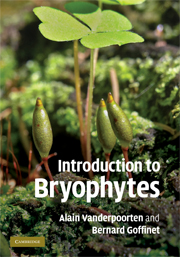1 - Evolutionary significance of bryophytes
Published online by Cambridge University Press: 05 June 2012
Summary
Vascular plants, particularly seed plants, dominate vegetation throughout much of the world today, from the lush rainforests of the tropics harbouring a vast diversity of angiosperms, to the boreal forests of coniferous trees, draping the northern latitudes of the globe. This dominance in the landscape is the result of a long evolutionary history of plants conquering land.
Evolution is the result of a suite of incessant attempts to improve fitness and take advantage of opportunities, such as escaping competition and occupying a new habitat. Pilgrims, fleeing the biotic interactions in the aquatic habitat, faced severe abiotic selection forces on land. How many attempts were made to conquer land is not known, but at least one of them led to the successful establishment of a colony. At least one population of one species had acquired a suite of traits that allowed it to complete its life cycle and persist on land. The ancestor to land plants was born. It may have taken another 100 million years for plants to overcome major hurdles, but by the Devonian Period (approximately 400 mya), a diversity of plants adapted to the terrestrial environment and able to absorb water and nutrients, and transport and distribute them throughout their aerial shoots, occupied at least some portions of the land masses. Soon thereafter, plants were freed from the necessity of water for sexual reproduction, by transporting their sperm cells in pollen grains carried by wind or insects to the female sex organs, and seeds protected the newly formed embryo.
- Type
- Chapter
- Information
- Introduction to Bryophytes , pp. 1 - 25Publisher: Cambridge University PressPrint publication year: 2009



